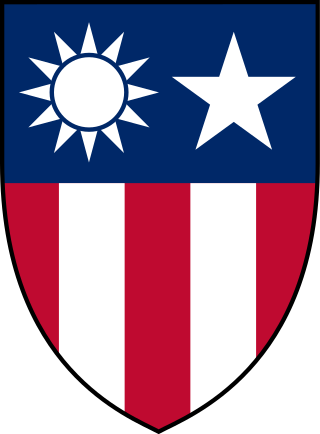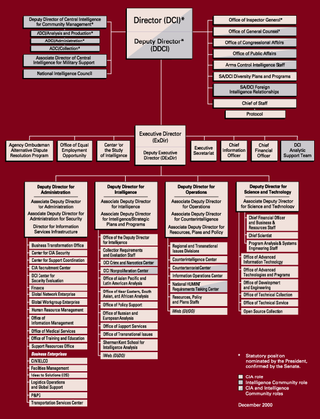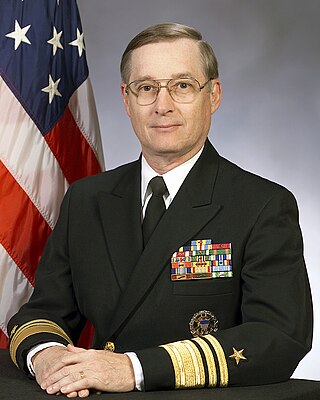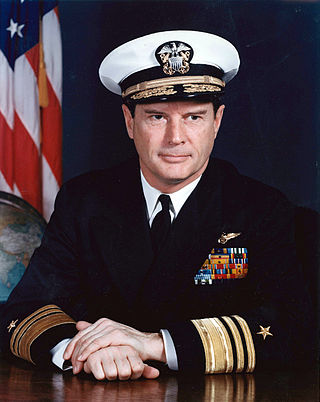Related Research Articles

The Defense Intelligence Agency (DIA) is an intelligence agency and combat support agency of the United States Department of Defense, specializing in defense and military intelligence.

The United States Indo-Pacific Command (USINDOPACOM) is the unified combatant command of the United States Armed Forces responsible for the Indo-Pacific region.

China Burma India Theater (CBI) was the United States military designation during World War II for the China and Southeast Asian or India–Burma (IBT) theaters. Operational command of Allied forces in the CBI was officially the responsibility of the Supreme Commanders for South East Asia or China. However, US forces in practice were usually overseen by General Joseph Stilwell, the Deputy Allied Commander in China; the term "CBI" was significant in logistical, material and personnel matters; it was and is commonly used within the US for these theaters.
The Strategic Support Branch (SSB) was a United States intelligence organization created by the Department of Defense (DoD) with support from the Defense Intelligence Agency (DIA) and the Central Intelligence Agency (CIA). The SSB's mission was to provide an intelligence capability for field operation units, and U.S. Special Operations Forces (SOF), in support of anti-terrorism and counter-terrorism missions in war zones and beyond. The SSB has been dissolved with many of its activities and capabilities transferred to DIA's Defense Clandestine Service.

Pacific Ocean Areas was a major Allied military command in the Pacific Ocean theater of World War II. It was one of four major Allied commands during the Pacific War and one of three United States commands in the Asiatic-Pacific Theater. Admiral Chester W. Nimitz of the U.S. Navy, Commander in Chief, U.S. Pacific Fleet, headed the command throughout its existence.

James Arthur Williams was a United States Army lieutenant general. Williams served as Director of the Defense Intelligence Agency in the 1980s. He was a 1987 inductee of the Military Intelligence Hall of Fame and was the chairman of the board of directors for the National Military Intelligence Association.

Harry Edward Soyster is a retired United States Army Lieutenant General.

Lieutenant General Samuel Vaughan Wilson, aka "General Sam," completed his active military career in the fall of 1977, having divided his service almost equally between special operations and intelligence assignments.

The Directorate of Operations (DO), less formally called the Clandestine Service, is a component of the US Central Intelligence Agency. It was known as the Directorate of Plans from 1951 to 1973; as the Directorate of Operations from 1973 to 2005; and as the National Clandestine Service (NCS) from 2005 to 2015.

The United States Department of Defense is an executive branch department of the federal government of the United States charged with coordinating and supervising all agencies and functions of the U.S. government directly related to national security and the United States Armed Forces. As of June 2022, the U.S. Department of Defense is the largest employer in the world, with over 1.34 million active-duty service members, including soldiers, marines, sailors, airmen, and guardians. DoD also maintains over 778,000 National Guard and reservists, and over 747,000 civilians bringing the total to over 2.87 million employees. Headquartered at the Pentagon in Arlington County, Virginia, just outside Washington, D.C., DoD's stated mission is to provide "the military forces needed to deter war and ensure our nation's security".

The South West Pacific theatre, during World War II, was a major theatre of the war between the Allies and the Axis. It included the Philippines, the Dutch East Indies, Borneo, Australia and its mandate Territory of New Guinea and the western part of the Solomon Islands. This area was defined by the Allied powers' South West Pacific Area (SWPA) command.
National governments deal in both intelligence and military special operations functions that either should be completely secret, or simply cannot be linked to the sponsor. It is a continuing and unsolved question for governments whether clandestine intelligence collection and covert action should be under the same agency. The arguments for doing so include having centralized functions for monitoring covert action and clandestine HUMINT and making sure they do not conflict, as well as avoiding duplication in common services such as cover identity support, counterespionage, and secret communications. The arguments against doing so suggest that the management of the two activities takes a quite different mindset and skills, in part because clandestine collection almost always is on a slower timeline than covert action.

The CIA publishes organizational charts of its agency. Here are a few examples.

Patrick M. Hughes is a retired United States Army officer who served as the 12th Director of the Defense Intelligence Agency (DIA). Previously, he was Director of Intelligence for the US Joint Chiefs of Staff from 1994 to 1996 and the Director of Intelligence at United States Central Command from 1992 to 1994. He was the Commanding General, United States Army Intelligence Agency, and the Assistant Deputy Chief of Staff for Intelligence, U.S. Army from 1990 until 1992. He joined the United States Department of Homeland Security in 2003 as the Assistant Secretary for Information Analysis (Intelligence), and departed from DHS and Government service in March 2005.

Thomas Ray Wilson is a retired United States Navy vice admiral. He previously served as Director of the Defense Intelligence Agency from July 1999 to July 2002.

Vice Admiral Lowell Edwin Jacoby, USN was the 14th director of the Defense Intelligence Agency. Previously he was Director for Intelligence (J-2) Joint Staff in the Office of the Chairman of the Joint Chiefs of Staff from 1999 to 2002, and the Director of Naval Intelligence and commander, Office of Naval Intelligence from 1997 to 1999. He was the Director for Intelligence, U.S. Pacific Command from 1994 to 1997 and Commander, Joint Intelligence Center, Pacific from 1992 to 1994. He was Assistant Chief of Staff, Intelligence, U.S. Pacific Fleet from 1990 to 1992.

Vincent Paul de Poix was a vice admiral in the United States Navy. He began his career as a naval aviator and fighting in World War II aboard USS Enterprise (CV-6). A graduate of the United States Naval Academy, he became the first captain of the newly commissioned USS Enterprise (CVN-65) in November 1961. He later participated in the Vietnam War, and commanded the United States Second Fleet. He was Director of the Defense Intelligence Agency from August 1972 to September 1974.

The Defense Clandestine Service (DCS) is an arm of the Defense Intelligence Agency (DIA), which conducts clandestine espionage, intelligence gathering activities and classified operations around the world to provide insights and answer national-level defense objectives for senior U.S. policymakers and American military leaders. Staffed by civilian and military personnel, DCS is part of DIA's Directorate of Operations and works in conjunction with the Central Intelligence Agency's Directorate of Operations and the U.S. military's Joint Special Operations Command. DCS consists of about 500 clandestine operatives, which is roughly how many case officers the CIA maintained in the early 2000s prior to its expansion.
The Military Intelligence Board (MIB) serves as the senior-level board for coordination of intelligence assets in support of military operations globally within the United States Government. The board is chaired by the Defense Intelligence Agency, a component of the United States Department of Defense, and seeks consensus across commands, agencies, and services. It serves as a forum to discuss any intelligence issues related to the military.
References
- 1 2 Klauberg, William J. (1994). Joint Military Operations "... from the Sea" - Reorienting Naval Operational Intelligence (PDF ed.). Newport, Rhode Island: Naval War College. p. 13.
- ↑ Marchio, James D. "The Evolution and Relevance of Joint Intelligence Centers". Central Intelligence Agency. Archived from the original on June 13, 2007. Retrieved 6 September 2018.
- 1 2 3 Marchio, James D. (1996). Days of Future Past: Joint Intelligence in World War II (PDF ed.). Washington DC: National Defense University. pp. 117–122.
- ↑ Friedman, Herbert A. "The United States PSYOP Organization in the Pacific During World War II" . Retrieved 6 September 2018.
- ↑ Brooks, Randy; McKeever, Chuck. "Split Based Intelligence Operations During Desert Storm: "A Glimpse of the Future Digital Army"" (PDF). OSS.net. Retrieved 6 September 2018.
